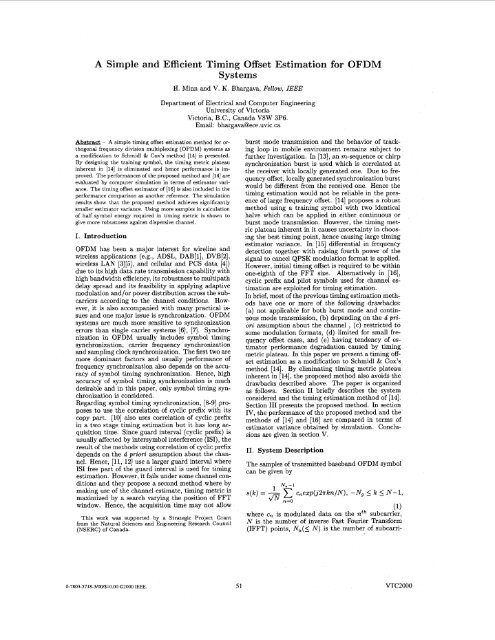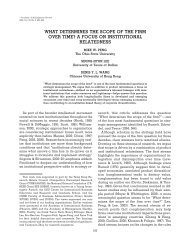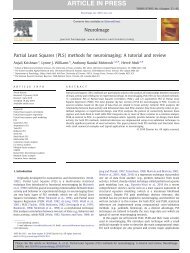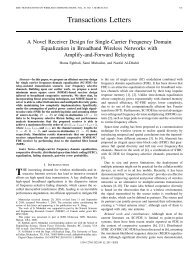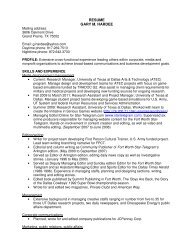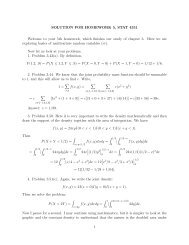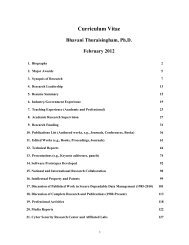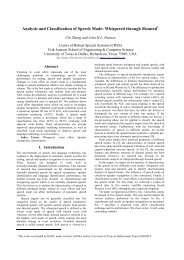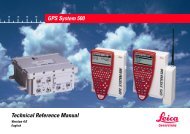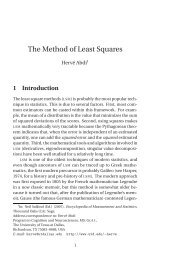A simple and efficient timing offset estimation for OFDM systems ...
A simple and efficient timing offset estimation for OFDM systems ...
A simple and efficient timing offset estimation for OFDM systems ...
You also want an ePaper? Increase the reach of your titles
YUMPU automatically turns print PDFs into web optimized ePapers that Google loves.
A Simple <strong>and</strong> Efficient Timing Offset Estimation <strong>for</strong> <strong>OFDM</strong>SystemsH. Minn <strong>and</strong> V. K. Bhargava, Fellow, IEEEDepartment of Electrical <strong>and</strong> Computer EngineeringUniversity of VictoriaVictoria, B.C., Canada V8W 3P6.Email: bhargava@ece.uvic.caAbstract - A <strong>simple</strong> <strong>timing</strong> <strong>offset</strong> <strong>estimation</strong> method <strong>for</strong> orthogonalfrequency division multiplexing (<strong>OFDM</strong>) <strong>systems</strong> asa modification to Schmidl & Cox’s method [14] is presented.By designing the training symbol, the <strong>timing</strong> metric plateauinherent in [14] is eliminated <strong>and</strong> hence per<strong>for</strong>mance is improved.The per<strong>for</strong>mances of the proposed method <strong>and</strong> [14] areevaluated by computer simulation in terms of estimator variance.The <strong>timing</strong> <strong>offset</strong> estimator of [16] is also included in theper<strong>for</strong>mance comparison as another reference. The simulationresults show that the proposed method achieves significantlysmaller estimator variance. Using more samples in calculationof half symbol energy required in <strong>timing</strong> metric is shown togive more robustness against dispersive channel.I. Introduction<strong>OFDM</strong> has been a major interest <strong>for</strong> wireline <strong>and</strong>wireless applications (e.g., ADSL, DAB[l], DVB[2],wireless LAN [3][5], <strong>and</strong> cellular <strong>and</strong> PCS data [4])due to its high data rate transmission capability withhigh b<strong>and</strong>width efficiency, its robustness to multipathdelay spread <strong>and</strong> its feasibility in applying adaptivemodulation <strong>and</strong>/or power distribution across the subcarriersaccording to the channel conditions. However,it is also accompanied with many practical issues<strong>and</strong> one major issue is synchronization. <strong>OFDM</strong><strong>systems</strong> are much more sensitive to synchronizationerrors than single carrier <strong>systems</strong> [6], [7]. Synchronizationin <strong>OFDM</strong> usually includes symbol <strong>timing</strong>synchronization, carrier frequency synchronization<strong>and</strong> sampling clock synchronization. The first two aremore dominant factors <strong>and</strong> usually per<strong>for</strong>mance offrequency synchronization also depends on the accuracyof symbol <strong>timing</strong> synchronization. Hence, highaccuracy of symbol <strong>timing</strong> synchronization is muchdesirable <strong>and</strong> in this paper, only symbol <strong>timing</strong> synchronizationis considered.Regarding symbol <strong>timing</strong> synchronization, [8-91 proposesto use the correlation of cyclic prefix with itscopy part. [lo] also uses correlation of cyclic prefixin a two stage <strong>timing</strong> <strong>estimation</strong> but it has long acquisitiontime. Since guard interval (cyclic prefix) isusually affected by intersymbol interference (ISI), theresult of the methods using correlation of cyclic prefixdepends on the 6 priori assumption about the channel.Hence, [ll, 121 use a larger guard interval whereIS1 free part of the guard interval is used <strong>for</strong> <strong>timing</strong><strong>estimation</strong>. However, it fails under some channel conditions<strong>and</strong> they propose a second method where bymaking use of the channel estimate, <strong>timing</strong> metric ismaximized by a search varying the position of FFTwindow. Hence, the acquisition time may not allowThis work was supported by a Strategic Project Grantfrom the Natural Sciences <strong>and</strong> Engineering Research Council(NSERC) of Canada.burst mode transmission <strong>and</strong> the behavior of trackingloop in mobile environment remains subject tofurther investigation. In [13], an m-sequence or chirpsynchronization burst is used which is correlated atthe receiver with locally generated one. Due to frequency<strong>offset</strong>, locally generated synchronization burstwould be different from the received one. Hence the<strong>timing</strong> <strong>estimation</strong> would not be reliable in the presenceof large frequency <strong>offset</strong>. [14] proposes a robustmethod using a training symbol with two identicalhalve which can be applied in either continuous orburst mode transmission. However, the <strong>timing</strong> metricplateau inherent in it causes uncertainty in choosingthe best <strong>timing</strong> point, hence causing large <strong>timing</strong>estimator variance. In [15] differential in frequencydetection together with raising fourth power of thesignal to cancel QPSK modulation <strong>for</strong>mat is applied.However, initial <strong>timing</strong> <strong>offset</strong> is required to be withinone-eighth of the FFT size. Alternatively in [16],cyclic prefix <strong>and</strong> pilot symbols used <strong>for</strong> channel <strong>estimation</strong>are exploited <strong>for</strong> <strong>timing</strong> <strong>estimation</strong>.In brief, most of the previous <strong>timing</strong> <strong>estimation</strong> methodshave one or more of the following drawbacks:(a) not applicable <strong>for</strong> both burst mode <strong>and</strong> continuousmode transmission, (b) depending on the a’ prioriassumption about the channel , (c) restricted tosome modulation <strong>for</strong>mats, (d) limited <strong>for</strong> small frequency<strong>offset</strong> cases, <strong>and</strong> (e) having tendency of estimatorper<strong>for</strong>mance degradation caused by <strong>timing</strong>metric plateau. In this paper we present a <strong>timing</strong> <strong>offset</strong><strong>estimation</strong> as a modification to Schmidl & Cox’smethod [14]. By eliminating <strong>timing</strong> metric plateauinherent in [14], the proposed method also avoids thedrawbacks described above. The paper is organizedas follows. Section I1 briefly describes the systemconsidered <strong>and</strong> the <strong>timing</strong> <strong>estimation</strong> method of [14].Section I11 presents the proposed method. In sectionIV, the per<strong>for</strong>mance of the proposed method <strong>and</strong> themethods of [14] <strong>and</strong> [16] are compared in terms ofestimator variance obtained by simulation. Conclusionsare given in section V.11. System DescriptionThe samples of transmitted baseb<strong>and</strong> <strong>OFDM</strong> symbolcan be given byNu-1~(Ic) = - c,ezp(p(j27rkn/~), -N~5 IC 5 N-I,fl n=O(1)where cn is modulated data on the nth subcarrier,N is the number of inverse Fast Fourier Trans<strong>for</strong>m(IFFT) points, Nu(< N ) is the number of subcarri-0-7803-5718-3/00/$10.00 02000 IEEE. 51 VTC2000
ers, Ng is the number of guard samples, j = fl<strong>and</strong> the sampling period is Tu/N with l/Tu beingsubcarrier spacing. Consider a discrete-time channelcharacterized byK-1h(k) = hlb(k - 71)l=Owhere b(k) represents dirac-delta function, {hl} complexpath gains, (71) path time delays which are assumedin multiple of <strong>OFDM</strong> samples, <strong>and</strong> K the totalnumber of paths. Then the received samples, assumingperfect sampling clock, can be given byK-1r(k) = ezp(j2nkw/~) hls(k - 71 +E) + n(k)l=O(3)where w is the carrier frequency <strong>offset</strong> normalizedto subcarrier spacing, E is <strong>timing</strong> <strong>offset</strong> in units of<strong>OFDM</strong> samples <strong>and</strong> n(k) is the sample of zero meancomplex Gaussian noise process with variance 0:.Suppose the sample indexes of perfectly synchronized<strong>OFDM</strong> symbol be {-Ng, ..., -1, 0, 1, ..., N - 1)<strong>and</strong> maximum channel delay spread be T, . Then ifE E {-Ng +T,~~, -Ng + T + 1,. ~ .. ~ , 0}, the ~ orthogonalityamong the subcarriers will not be destroyed<strong>and</strong> the <strong>timing</strong> <strong>offset</strong> will only introduce a phase rotationin every subcarrier symbol Ym at the FFT outputasY, = e~p(j2~me/N)c,H~+n,, -Ng+rmaZ 5 E < 0(4)where m is subcarrier index, H, is channel frequencyresponse to the mth subchannel, i.e., {Hm} =DFT(h(lc)), <strong>and</strong> nm is complex Gaussian noise term.For coherent system, this phase rotation is compensatedin channel equalization which sees it as a channelintroduced phase shift. If the <strong>timing</strong> estimateis outside the above range, the orthogonality amongthe subcarriers will be destroyed by the resulting ISI.Then the FFT output subcarrier symbols are givenbYcapacity efficiency can be obtained. With this aspect,the per<strong>for</strong>mance of the symbol <strong>timing</strong> synchronizationalgorithms will be evaluated by the <strong>timing</strong>estimator variance.The symbol <strong>timing</strong> estimator finds the start of the<strong>OFDM</strong> symbol. The correct symbol <strong>timing</strong> point willbe taken as the start of the useful part of the <strong>OFDM</strong>symbol (i.e., the start of FFT window <strong>for</strong> demodulation).Let the training symbol (excluding cyclic prefix)contain two identical halves in time domain eachhaving L = N/2 samples. At the receiver there willbe a phase difference between the samples in the firsthalf <strong>and</strong> their replica in the second half caused bythe carrier frequency <strong>offset</strong>. Training data is usuallya PN sequence. Then the Schmidl & Cox's <strong>timing</strong>estimator [14] takes as the start of the symbol themaximum point of the <strong>timing</strong> metric given bywhere d is a time index corresponding to the firstsample in a window of 2L samples <strong>and</strong> Pl(d) is correlationmetric given byL-1Pi(d)= xr*(d+m).r(d+m+L) (7)m=Owhere ()* represents conjugation <strong>and</strong> Rl(d) representsenergy of half <strong>OFDM</strong> symbol <strong>and</strong> is included<strong>for</strong> normalization of the correlation metric in account<strong>for</strong> the large fluctuation of the <strong>OFDM</strong> sample amplitudes<strong>and</strong> given byL-1Rl(d) = (r(d + m + L)12 (8)m=OThe <strong>timing</strong> metric reaches a plateau (see Fig. 2)which leads to some uncertainty as to the start ofthe frame. To alleviate this, [14] proposes an averagingmethod where the maximum point is first found<strong>and</strong> then two points with 90% of the maximum value,one to the left <strong>and</strong> the other to the right of the maximumpoint, are found. The <strong>timing</strong> estimate is takenas the average of the two 90% points.111. Proposed Methodwhere the extra term IE(m) results from IS1 <strong>and</strong> interchannelinterference (ICI) caused by the loss o<strong>for</strong>thogonality among the subcarriers (see [13] <strong>for</strong> details).The useful term also suffers a slight gain lossbut <strong>for</strong> large N, it is negiligible. The main detrimentaleffect is caused by the extra ISI+ICI term.Thus, the guard interval should be long enough <strong>for</strong>the <strong>timing</strong> estimate to lie within the range describedabove. On the other h<strong>and</strong>, longer guard intervaltranslates into more system capacity loss due to overhead.Hence high per<strong>for</strong>mance <strong>timing</strong> synchronizationis much desirable <strong>for</strong> higher system per<strong>for</strong>mance<strong>and</strong> capacity efficiency. The smaller the variance of<strong>timing</strong> estimator is, the shorter the guard interval canbe designed, <strong>and</strong> hence less overhead <strong>and</strong> increasedThe samples of the training symbol (excluding cyclicprefix) are designed to be of the <strong>for</strong>ms=[AA -A -A] (9)where A represents samples of length L = N/4 generatedby N/4 point IFFT of N,/4 length modulateddata of a PN sequence. If desired, the abrupt amplitudechange due to sign conversion in the trainingsymbol can easily be avoided by modifying the PN sequencesuch that the sum of the corresponding modulateddata equals zero. The <strong>timing</strong> metric is givenby0-7803-5718-3/00/$10.00 02000 IEEE. 52VTC2000
correlationwindow ------A correlation window -.................... ..........CP + +CP = Cyclic Prefix(a) at exact symbol <strong>timing</strong> point(b) be<strong>for</strong>e exact symbol <strong>timing</strong> pointFig. 1. Correlation of the training symbol: Schmidl & Cox’s method (upper), Proposed method (lower)where1 L-1&(d) = r*(d+ 2Lk + m) . r(d+ 2Lk+ m + L)k=O 7n=O<strong>and</strong>1 L-1R2(d) = Jr(d + 2Lk +VI + L)I2 (12)k=O m=OIn above equations, P2(d) <strong>and</strong> R2(d) can be calculatediteratively. The training symbol patterns of[14] <strong>and</strong> proposed method are shown in Fig.(l). Alsoshown is the elimination of <strong>timing</strong> metric plateau inherentin [14] by proper design of the training symbolin the proposed method. For training symbol of [14],the correlation metric has its peak <strong>for</strong> the whole intervalof cyclic prefix (under no noise <strong>and</strong> distortioncondition) while the proposed training symbol has itspeak of correlation metric at the correct FFT windowstarting point since off that point, correlation ofsome samples results in negative values as shown inFig. (1) hence eliminating the correlation metric peakplateau.The <strong>timing</strong> metrics of [14] (Eq. (6)), <strong>and</strong> the proposedmethod (Eq. (10)) are shown in Fig. 2 underno noise <strong>and</strong> distortion condition with the system parametersgiven in section IV. The correct <strong>timing</strong> point(index 0 in the figure) is taken as the start of theuseful part of training symbol (after cyclic prefix).As discussed previously, the proposed method doesnot have <strong>timing</strong> metric plateau <strong>and</strong> consequently itachieves better accuracy in <strong>timing</strong> <strong>offset</strong> <strong>estimation</strong>.In calculation of half symbol energy, N samples insteadof N/2 samples can be used to get more reliableresult. Then <strong>for</strong> both methods, Rl(d) <strong>and</strong> R*(d) canbe replaced by the following:, \ < .ow’ ’-400 -300 -200 -100 0 100 200 300 400Time (sample)Fig. 2. Timing metric under no noise <strong>and</strong> distortion conditionIV. SIMULATION RESULTS AND DISCUSSIONPer<strong>for</strong>mance of the <strong>timing</strong> <strong>offset</strong> estimators have beeninvestigated by computer simulation <strong>for</strong> five cases: (I)Schmidl & Cox method (Eq. (6) with 90% maximumpoints averaging), (11) Schmidl & Cox method withmodified R(d) (same as (I), except that Rl(d) is replacedby R(d)), (111) the method from [16],(IV) ProposedMethod (Eq. (lo)), <strong>and</strong> (V) Proposed Methodusing R(d) in stead of R2(d). The system used is1000 subcarriers <strong>OFDM</strong> system with 1024 point FFT,10% guard interval (102 samples), carrier frequency<strong>offset</strong> of 12.4 subcarrier spacing, QPSK modulation<strong>and</strong> 10000 simulation runs. Two channel conditions0-7803-5718-3/00/$10.00 02000 IEEE. 53 VTC2000
30Lz=J-*--*--*---E 205z -10-vE .-$ -20 -cB3=0 -30 ~5 -5t-1%- II. Schmidl& Coxwith Eq(13)+ 111. Ref.[16]46. IV. Proposed Method+ V. ProposedMethodwith Eq.(13)' 11EI30 -lotp -20-0- 11. Schmidl &Coxwith Eq.(13)-3- 111. Ref.[16]. +#. IV. Proposed Method+ V. ProposedMethodwith Eq.(13)-60 10 5 10 15 20 25SNR (dB)Fig. 3. Mean of the <strong>timing</strong> <strong>offset</strong> estimators in AWGN channel-50 ' I0 5 10 15 20 25SNR (dB)Fig. 5. Mean of the <strong>timing</strong> <strong>offset</strong> estimators in IS1 channel0 5 10 15 20 25SNR (dB)Fig. 4. Timing <strong>offset</strong> estimator variance in AWGN channel0 5 10 15 20 25SNR (dB)Fig. 6. Timing <strong>offset</strong> estimator variance in IS1 channelare considered: a) An AWGN channel with no intersymbolinterference (ISI) (it will be called AWGNchannel) <strong>and</strong> b) An AWGN channel with IS1 (it willbe called IS1 channel). The IS1 channel is modelledas sixteen paths with path delays ~i of 0,4,8,. . . ,60samples <strong>and</strong> path gains given byFor the <strong>timing</strong> estimator of [16], the additional parametersare: one pilot every 40th subcarrier <strong>and</strong>dummy SNR value SNR = 5dB.The means <strong>and</strong> variances of the <strong>timing</strong> <strong>offset</strong> estimatesin AWGN channel are shown in Figs. (3) <strong>and</strong>(4), <strong>and</strong> in IS1 channel are in Figs. (5) <strong>and</strong> (6) respec-tively. For AWGN channel, the means of the cases I<strong>and</strong> I1 are about the middle of <strong>timing</strong> metric plateau(within the cyclic prefix) while the means of the cases111, IV, <strong>and</strong> V are about the correct <strong>timing</strong> point. ForIS1 channel, the means are observed to be shifted tothe right in time axis (i.e. delayed) by some amountdepending on the shapes of the <strong>timing</strong> metric <strong>and</strong> IS1channel profile. Note that if the <strong>timing</strong> estimate is desiredto lie within guard interval, then the means ofthe cases 111, IV, <strong>and</strong> V can easily be shifted to theleft (i.e., advanced) by appropriate design amount.As <strong>for</strong> the variances, the following are observed:In AWGN channel, cases I, I1 <strong>and</strong> I11 show floorin estimator variance curves while the proposedmethods (cases IV <strong>and</strong> V) do not. In IS1 channel,all methods have estimator variance floor.Per<strong>for</strong>mance of case I1 is better than case I <strong>for</strong>all conditions considered, at the expense of some0-7803-57 18-3/00/$10.00 02000 IEEE. 54VTC2000
additional complexity. The smaller variance ofcase I1 is due to using more samples to calculatehalf symbol energy used in <strong>timing</strong> metric.Proposed methods (cases IV <strong>and</strong> V) have significantlysmaller estimator variance than Schmidl& Cox’s method (case I) <strong>for</strong> all conditions considered.The better per<strong>for</strong>mance of the proposedmethods is generally due to the absence of <strong>timing</strong>metric plateau.Comparing proposed methods to case I11(Ref.[l6]), in AWGN channel, we see that casesIV <strong>and</strong> V have significantly smaller estimatorvariance; while in IS1 channel, case IV hasslightly larger variance <strong>for</strong> SNR values greaterthan 10 dB but case V has significantly smallervariances.In AWGN channel, the slope of the <strong>timing</strong> metricoff the correct <strong>timing</strong> point determines the estimatorvariance (see cases I <strong>and</strong> I1 vs cases IV,<strong>and</strong> V in Fig. 4).In IS1 channel, using all the samples over onesymbol period (excluding cyclic prefix) to calculatethe half symbol energy (i.e. using R) hasmore effect on reducing the estimator variancethan the slope of the <strong>timing</strong> metric (see case IVvs. cases I1 <strong>and</strong> V in Fig. 6).As an overall evaluation <strong>for</strong> both channel conditions,case V (proposed method using R) per<strong>for</strong>msthe best.The cases I1 <strong>and</strong> V have some additional complexitydue to using R as compared to the case I. However,cases IV <strong>and</strong> V do not need averaging of <strong>timing</strong> metricas required in cases I <strong>and</strong> 11. Hence case IV has evensmaller complexity than case I.Similar to the proposed training symbol in this paperwhich is composed of 4 parts, the training symbolcan be designed to be composed of more parts<strong>and</strong> have steeper roll-off <strong>timing</strong> metric off the correct<strong>timing</strong> point so that better <strong>timing</strong> <strong>estimation</strong> can beachieved.V. ConclusionsA <strong>simple</strong> <strong>timing</strong> <strong>offset</strong> <strong>estimation</strong> method <strong>for</strong> <strong>OFDM</strong><strong>systems</strong> is presented as a modification to Schmidl &Cox’s method [14] where a training symbol containingtwo identical halves is used. The proposed methoduses a training symbol containing four equal lengthparts: the first two are identical <strong>and</strong> the last twoare the negative of the first two. By eliminating the<strong>timing</strong> metric plateau inherent in [14], the proposedmethod achieves a per<strong>for</strong>mance improvement. Moreover,using all samples over one symbol period (excludingguard interval), instead of over half symbolperiod, in the calculation of half symbol energy requiredin <strong>timing</strong> metric is shown to give more robustnessto dispersive channel. The simulation resultsshow that proposed method has significantly smallerestimator variance than [14] under both AWGN channel<strong>and</strong> IS1 channel. The per<strong>for</strong>mance of the methodin [16] is also included in the comparison as anotherreference. As an overall per<strong>for</strong>mance <strong>for</strong> both channels,the proposed method using all samples over onesymbol period in calculation of half symbol energygives the best result.References[l] P. Shelswell, “The C<strong>OFDM</strong> modulation system: the heartof digital audio broadcasting,” Elec. Commun. Eng. Journal,June 1995, pp. 127-136.[Z] U. Reimers, “Digital - video broadcasting,” - ZEEE CommunicationsMagazine, Vol. 36, No. 6, Jun 1998, pp. 104-110.M. Aldinger, “Multicarrier C<strong>OFDM</strong> scheme in high bit rateradio local area networks,” Pmc. PIMRC, 1994, pp. 969-973.L.J. Cimini, Jr., J.C. Chuang <strong>and</strong> N.R. Sollenberger, ‘I Advancedcellular internet services,” IEEE CommunicationsMagazine, Vol. 36, No. 10, Oct 1998, pp. 150-159.J.C-I. Chuang <strong>and</strong> N.R. Sollenberger, “Wideb<strong>and</strong> wirelessdata access based on <strong>OFDM</strong> <strong>and</strong> dynamic packet assignment,”Wireless Communications <strong>and</strong> Networking Conj.,New Orleans, USA, Sept. 1999, pp. 757-761.T. Pollet, M. Van Blade1 <strong>and</strong> M. Moeneclaey, “BER sensitivityof <strong>OFDM</strong> <strong>systems</strong> to carrier frequency <strong>offset</strong> <strong>and</strong>wiener phase noise,” ZEEE Pans. on Comms., Vol. 43, No.2/3/4, Feb/Mar/Apr 1995, pp. 191-193.M. Gudmundson <strong>and</strong> P.O. Anderson, “Adjacent channelinterference in an <strong>OFDM</strong> system,” Proc. Vehicular Tech.Conf, Atlanta, GA, May 1996, pp. 918-922.J-J. van de Beek, M. S<strong>and</strong>ell <strong>and</strong> P.O. Borjesson, “ML<strong>estimation</strong> of time <strong>and</strong> frequency <strong>offset</strong> in <strong>OFDM</strong> <strong>systems</strong>”IEEE Pans. Signal Proc., Vol. 45, no. 7, July 1997, pp.1800- 1805.D. L<strong>and</strong>strom, J.M. Arenas, J.J van de Beek, P.O.Borjesson, M-L.Boucheret <strong>and</strong> P.Odling, “Time <strong>and</strong> frequency<strong>offset</strong> <strong>estimation</strong> in <strong>OFDM</strong> <strong>systems</strong> employingpulse shaping,” Proc. Intl Conj. on Universal PersonalCommunications, San Diego, CA, USA, Vol. 45, no. 7, Oct1997, pp. 279-283.[lo] D. Lee <strong>and</strong> K. Cheun, “A new symbol <strong>timing</strong> recoveryalgorithm <strong>for</strong> <strong>OFDM</strong> <strong>systems</strong>,” ZEEE Trans. on Consum.Electronics, Vol. 43, No. 3, Aug 1997, pp. 767-775.[ll] M. Speth, F. Classen <strong>and</strong> H. Meyr, “Frame synchronizationof <strong>OFDM</strong> <strong>systems</strong> in frequency selective fadingchannels,” Proc. Vehicular Tech. Conf., Phoenix, Arizona,USA, May 1997, pp. 1807-1811.[la] M. Speth, D. Daecke <strong>and</strong> H. Meyr, “Minimum overheadburst synchronization <strong>for</strong> <strong>OFDM</strong> based broadb<strong>and</strong> transmission,”Proc. Global Telecom. Conf., Sydney, Australia,Nov 1998, pp. 2777-2782.[13] L. Hazy <strong>and</strong> M. El-Tanany, “Synchronization of <strong>OFDM</strong><strong>systems</strong> over frequency selective fading channels,” Proc.Vehicular Tech. Conf., Phoenix, Arizona, USA, May 1997,pp. 2094-2098.[14] T.M. Schmidl <strong>and</strong> D.C. Cox, “Robust frequency <strong>and</strong> <strong>timing</strong>synchronization <strong>for</strong> <strong>OFDM</strong>,” IEEE Rans. on Comms.,Vol. 45, No. 12, Dec 1997, pp. 1613-1621.[15] B. McNair, L.J. Cimini Jr. <strong>and</strong> N. Sollenberger, “A robust<strong>timing</strong> <strong>and</strong> frequency <strong>offset</strong> <strong>estimation</strong> scheme <strong>for</strong> orthogonalfrequency division multiplexing (<strong>OFDM</strong>) <strong>systems</strong>,”Proc. Vehicular Tech. Conf., Houston, Texas, USA, May1999, pp. 690-694.[E] D. L<strong>and</strong>strom, S.K. Wilson, 5.3. van de Beek, P. Odling<strong>and</strong> P.O. Borjesson, “Symbol time <strong>offset</strong> <strong>estimation</strong> in coherent<strong>OFDM</strong> <strong>systems</strong>,” Proc. Intl Conf. on Communications,Vancouver, BC, Canada, June 1999, pp. 500-505.0-7803-5718-3/00/$10.002000 IEEE. 55 VTC2000


